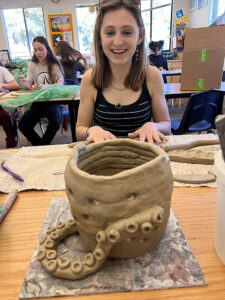Mount Madonna School eighth grade students have been working in their Technology, Engineering and Art class to create clay lamps that, when finished, will be wired and functionable.

“Part of being a good designer is understanding the qualities and limitations of materials,” said Willetts. “In this project, the students had to solve a lot of problems because of the special properties of clay. It has to be joined correctly or it will break in the firing. Only certain kinds of shapes will work because the clay contains a lot of water and will sag and crack under the pressure of gravity.”
Willetts continued: “The students learned three hand-building techniques: Coil, slab and pinch. In some cases, they had to combine techniques to get the shape they wanted. They worked out their ideas first with a prototype to see if the shape would hold. In many cases, it didn’t, and it was back to the drawing board! This kind of learning-by-doing problem solving is an important skill in design and innovation.”
In designing their lamps, students practiced the design process.
Next, students made prototypes and drawings of their lamp design. This included planning for enough “holes” or open spaces for line to shine through, as well as sturdy bases and needed openings for the light fixture and bulb, and space for the cord to enter the lamp, while still allowing it to sit stably on a flat surface.
As they completed their designs, the teachers gave each student a block of gray stoneware clay from which to fashion their lamp. While the clay was drying, students spent a week learning about the different ways electricity is generated and how it arrives at a wall outlet.
“They learned the difference between AC and DC electricity and how their light fixtures work,” said Welch, “and about processes that make electricity safer, so that when they wire up their lamps, they will understand what all the parts are for, why they have to be careful, and how they connect to the larger whole. Additionally, a certified electrician will inspect their work, to reinforce students’ sense of the importance of safety.”